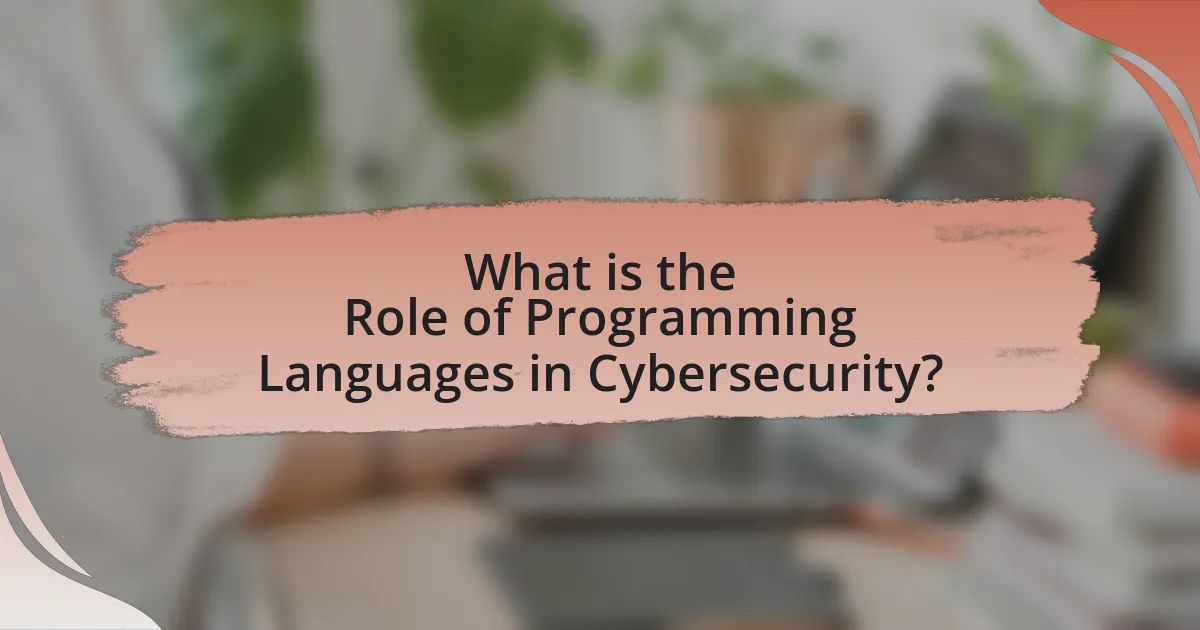The article focuses on the critical role of programming languages in cybersecurity, highlighting their importance in developing security tools, conducting vulnerability assessments, and creating secure applications. Key programming languages such as Python, C, C++, Java, and JavaScript are examined for their specific contributions to cybersecurity practices, including secure software development and threat detection. The article also addresses the challenges posed by programming languages, common vulnerabilities associated with them, and strategies for mitigating risks. Additionally, it emphasizes the necessity for cybersecurity professionals to possess programming knowledge to effectively analyze and address security threats.

What is the Role of Programming Languages in Cybersecurity?
Programming languages play a crucial role in cybersecurity by enabling the development of security tools, facilitating vulnerability assessments, and allowing for the creation of secure applications. These languages, such as Python, C, and Java, provide the necessary syntax and structure for writing scripts and programs that can detect, analyze, and mitigate security threats. For instance, Python is widely used for automating tasks and developing security tools due to its simplicity and extensive libraries, while C is essential for understanding low-level system vulnerabilities. The effectiveness of programming languages in cybersecurity is evidenced by their use in creating widely adopted security frameworks and tools, such as Metasploit and Wireshark, which are integral to penetration testing and network analysis.
How do programming languages contribute to cybersecurity practices?
Programming languages contribute to cybersecurity practices by enabling the development of secure software, facilitating vulnerability analysis, and supporting the creation of security tools. For instance, languages like Python and C++ are commonly used to write security scripts and tools that automate tasks such as penetration testing and malware analysis. Additionally, programming languages provide frameworks and libraries that help developers implement security features, such as encryption and authentication, directly into applications. The use of languages with strong typing and memory management, like Rust, can reduce common vulnerabilities such as buffer overflows, thereby enhancing overall security.
What are the key programming languages used in cybersecurity?
The key programming languages used in cybersecurity are Python, C, C++, Java, and JavaScript. Python is widely favored for its simplicity and extensive libraries, making it ideal for scripting and automation in security tasks. C and C++ are crucial for understanding low-level operations and developing exploits, as they provide direct access to system resources. Java is often used in enterprise environments, where security vulnerabilities can arise, while JavaScript is essential for web security, particularly in identifying and mitigating cross-site scripting attacks. These languages are integral to various cybersecurity functions, including penetration testing, malware analysis, and secure software development.
How do different programming languages address security vulnerabilities?
Different programming languages address security vulnerabilities through various built-in features and paradigms that enhance code safety. For instance, languages like Rust employ ownership and borrowing concepts to prevent memory-related vulnerabilities such as buffer overflows, which are common in languages like C and C++. Java, on the other hand, uses automatic garbage collection and a strong type system to mitigate risks associated with memory management and type errors. Python emphasizes readability and simplicity, which can reduce the likelihood of introducing security flaws during development. Additionally, languages like Go incorporate built-in concurrency features that help prevent race conditions, a common vulnerability in multi-threaded applications. These approaches are supported by research indicating that language design significantly impacts the prevalence of security vulnerabilities, as seen in studies published by the ACM and IEEE.
Why is understanding programming languages essential for cybersecurity professionals?
Understanding programming languages is essential for cybersecurity professionals because it enables them to analyze, identify, and mitigate vulnerabilities in software systems. Proficiency in programming languages allows these professionals to read and comprehend source code, which is crucial for detecting security flaws and understanding how malware operates. For instance, a 2020 study by the Cybersecurity & Infrastructure Security Agency (CISA) highlighted that 90% of successful cyberattacks exploit known vulnerabilities, many of which can be identified through code analysis. Thus, knowledge of programming languages directly contributes to a cybersecurity professional’s ability to protect systems effectively.
What skills related to programming languages are crucial for cybersecurity experts?
Crucial skills related to programming languages for cybersecurity experts include proficiency in languages such as Python, C, C++, Java, and JavaScript. Python is essential for scripting and automating tasks, while C and C++ are important for understanding low-level operations and vulnerabilities in software. Java is widely used in enterprise environments, making it valuable for security assessments, and JavaScript is critical for web security, particularly in identifying and mitigating cross-site scripting vulnerabilities. Mastery of these languages enables cybersecurity professionals to analyze code, develop security tools, and understand the intricacies of software vulnerabilities, thereby enhancing their effectiveness in protecting systems and networks.
How does programming knowledge enhance threat detection and response?
Programming knowledge enhances threat detection and response by enabling cybersecurity professionals to analyze and understand malicious code, automate detection processes, and develop effective countermeasures. With programming skills, experts can dissect malware, identify vulnerabilities in software, and create scripts that automate the monitoring of network traffic for suspicious activities. For instance, a study by the Ponemon Institute found that organizations with skilled programming staff can reduce incident response times by up to 50%, demonstrating the direct impact of programming expertise on improving cybersecurity outcomes.

What are the specific applications of programming languages in cybersecurity?
Programming languages are essential in cybersecurity for developing security tools, automating tasks, and analyzing vulnerabilities. For instance, Python is widely used for scripting and automating security tasks, such as penetration testing and network scanning, due to its extensive libraries and ease of use. C and C++ are critical for developing low-level security applications, including antivirus software and firewalls, as they allow for direct memory management and system-level access. Additionally, languages like Java and JavaScript are employed in web security to create secure applications and mitigate vulnerabilities like cross-site scripting (XSS) and SQL injection. The versatility of these programming languages enables cybersecurity professionals to effectively address various security challenges, making them indispensable in the field.
How do programming languages facilitate secure software development?
Programming languages facilitate secure software development by providing built-in security features, type safety, and frameworks that help developers identify and mitigate vulnerabilities. For instance, languages like Rust and Ada emphasize memory safety, reducing risks associated with buffer overflows and memory leaks. Additionally, many modern programming languages include libraries and tools for secure coding practices, such as input validation and encryption, which help prevent common attacks like SQL injection and cross-site scripting. The adoption of these languages and their features has been shown to significantly decrease the number of security flaws in software, as evidenced by studies indicating that languages with strong type systems lead to fewer runtime errors and vulnerabilities.
What coding practices help prevent security flaws in software?
Adopting secure coding practices is essential to prevent security flaws in software. Key practices include input validation, which ensures that data received from users is checked for correctness and safety, thereby mitigating risks like SQL injection and cross-site scripting. Additionally, employing proper error handling prevents the exposure of sensitive information through error messages. Using parameterized queries instead of dynamic SQL statements further protects against injection attacks. Regularly updating libraries and frameworks helps address known vulnerabilities, while implementing access controls ensures that users have the appropriate permissions. These practices are supported by the OWASP Top Ten, which outlines common security risks and best practices for secure coding.
How do programming languages support secure coding standards?
Programming languages support secure coding standards by providing built-in features and libraries that facilitate the implementation of security best practices. For instance, languages like Java and C# include automatic memory management and type safety, which help prevent common vulnerabilities such as buffer overflows and memory leaks. Additionally, many programming languages offer frameworks and tools that enforce secure coding guidelines, such as input validation and error handling, which are critical for mitigating risks like SQL injection and cross-site scripting. The inclusion of security-focused libraries, such as OWASP’s ESAPI for Java, further reinforces secure coding by providing developers with pre-built functions that adhere to security standards.
What role do programming languages play in penetration testing?
Programming languages are essential in penetration testing as they enable security professionals to develop tools, scripts, and exploits to identify vulnerabilities in systems. By utilizing languages such as Python, Ruby, and JavaScript, penetration testers can automate tasks, manipulate data, and create custom payloads tailored to specific environments. For instance, Python is widely used for its extensive libraries and ease of use, allowing testers to quickly write scripts for tasks like network scanning and vulnerability assessment. Additionally, knowledge of programming languages helps testers understand the underlying code of applications, facilitating the discovery of security flaws. This proficiency is supported by industry practices, where programming skills are often listed as prerequisites for penetration testing roles, highlighting their critical importance in effectively assessing and improving cybersecurity measures.
Which programming languages are most effective for writing exploits?
C and C++ are the most effective programming languages for writing exploits due to their low-level memory manipulation capabilities and direct access to system resources. These languages allow for precise control over hardware and memory, which is essential for crafting exploits that target vulnerabilities in software. For instance, buffer overflow attacks, which are common in exploit development, often rely on the ability to manipulate memory directly, a feature that C and C++ provide. Additionally, Python is also widely used for exploit development because of its simplicity and extensive libraries that facilitate rapid development and testing of exploits.
How do scripting languages enhance automation in penetration testing?
Scripting languages enhance automation in penetration testing by enabling the rapid development and execution of custom tools and scripts that streamline repetitive tasks. These languages, such as Python and Bash, allow penetration testers to automate scanning, exploitation, and reporting processes, significantly increasing efficiency and reducing human error. For instance, Python’s extensive libraries, like Scapy for packet manipulation and Requests for web interactions, facilitate the creation of tailored scripts that can perform complex tasks with minimal code. This capability is evidenced by the widespread use of automated frameworks like Metasploit, which relies on scripting to execute various penetration testing modules efficiently.

What challenges do programming languages present in cybersecurity?
Programming languages present several challenges in cybersecurity, primarily due to their inherent design flaws, complexity, and the potential for human error. For instance, languages like C and C++ allow direct memory access, which can lead to vulnerabilities such as buffer overflows, a common attack vector that has been exploited in numerous high-profile breaches. Additionally, the complexity of modern programming languages can obscure security issues, making it difficult for developers to identify and mitigate risks effectively. Research indicates that approximately 70% of security vulnerabilities arise from coding errors, highlighting the critical role that programming languages play in the security landscape.
How can programming language limitations affect security measures?
Programming language limitations can significantly affect security measures by introducing vulnerabilities that can be exploited by attackers. For instance, languages that lack strong type checking, such as JavaScript, can lead to issues like buffer overflows and injection attacks, as they allow for unintended data manipulation. Additionally, languages with poor memory management, like C and C++, can result in memory leaks and unauthorized access to sensitive data, as evidenced by numerous high-profile breaches attributed to such vulnerabilities. These limitations necessitate the implementation of additional security measures, such as rigorous code reviews and the use of security-focused libraries, to mitigate risks associated with the inherent weaknesses of the programming languages used.
What are common vulnerabilities associated with specific programming languages?
Common vulnerabilities associated with specific programming languages include buffer overflows in C and C++, SQL injection in PHP, and cross-site scripting (XSS) in JavaScript. Buffer overflows occur when a program writes more data to a buffer than it can hold, leading to potential code execution; this has been a well-documented issue in C and C++ due to their low-level memory management. SQL injection, prevalent in PHP applications, arises when user input is improperly sanitized, allowing attackers to manipulate database queries. JavaScript is often exploited for XSS attacks, where malicious scripts are injected into web pages viewed by other users, compromising their data. These vulnerabilities highlight the importance of secure coding practices tailored to the characteristics of each programming language.
How do legacy programming languages impact modern cybersecurity practices?
Legacy programming languages significantly impact modern cybersecurity practices by introducing vulnerabilities that stem from outdated coding paradigms and lack of support. Many legacy systems, such as those built in COBOL or Fortran, often contain unpatched security flaws due to their age and the diminishing number of developers familiar with these languages. For instance, a report from the National Institute of Standards and Technology (NIST) highlights that legacy systems are frequently targeted by cyberattacks because they lack modern security features, making them easier to exploit. Additionally, the integration of legacy code into contemporary applications can create security gaps, as newer programming languages may not adequately address the risks posed by older codebases. This interplay between legacy languages and modern cybersecurity practices necessitates a careful approach to system updates and security protocols to mitigate potential threats.
What strategies can be employed to mitigate programming language-related risks?
To mitigate programming language-related risks, organizations can adopt several strategies, including using type-safe languages, implementing static analysis tools, and conducting regular code reviews. Type-safe languages, such as Rust and Java, help prevent common vulnerabilities like buffer overflows by enforcing strict type checks at compile time. Static analysis tools, like SonarQube and Coverity, automatically analyze code for potential security flaws, allowing developers to address issues before deployment. Regular code reviews, involving peer assessments, enhance code quality and security by identifying vulnerabilities that automated tools may miss. These strategies collectively reduce the likelihood of security breaches associated with programming languages.
How can developers improve their coding practices to enhance security?
Developers can improve their coding practices to enhance security by adopting secure coding standards and conducting regular code reviews. Implementing secure coding standards, such as those outlined by organizations like OWASP, helps developers identify and mitigate common vulnerabilities, including SQL injection and cross-site scripting. Regular code reviews, which involve peer assessments of code for security flaws, have been shown to reduce vulnerabilities significantly; studies indicate that code reviews can decrease security issues by up to 50%. Additionally, utilizing automated security testing tools during the development process can help identify potential security weaknesses early, further reinforcing secure coding practices.
What tools are available to analyze and secure code written in various programming languages?
Static analysis tools such as SonarQube, Checkmarx, and Fortify are available to analyze and secure code written in various programming languages. SonarQube provides continuous inspection of code quality and security vulnerabilities across multiple languages, while Checkmarx focuses on identifying security flaws in the code during the development process. Fortify offers a comprehensive suite for static and dynamic application security testing, ensuring that applications are secure from the ground up. These tools are widely recognized in the industry for their effectiveness in enhancing code security and maintaining high-quality standards.
What best practices should cybersecurity professionals follow regarding programming languages?
Cybersecurity professionals should prioritize secure coding practices when using programming languages. This includes validating input to prevent injection attacks, employing proper error handling to avoid information leakage, and utilizing secure libraries and frameworks that are regularly updated to mitigate vulnerabilities. According to the OWASP Top Ten, many security issues stem from improper coding practices, emphasizing the need for developers to adhere to established security guidelines. Additionally, professionals should conduct regular code reviews and static analysis to identify potential security flaws early in the development process, thereby reducing the risk of exploitation.
How can continuous learning in programming languages benefit cybersecurity careers?
Continuous learning in programming languages significantly enhances cybersecurity careers by equipping professionals with the skills to understand and mitigate vulnerabilities in software systems. As cyber threats evolve, knowledge of multiple programming languages allows cybersecurity experts to analyze code, identify security flaws, and develop effective countermeasures. For instance, proficiency in languages like Python and C++ enables professionals to write scripts for automation and analyze malware, while understanding JavaScript is crucial for securing web applications. According to a report by the Cybersecurity & Infrastructure Security Agency (CISA), continuous education in programming languages is essential for staying ahead of emerging threats, as it fosters adaptability and innovation in security practices.
What resources are recommended for mastering programming languages in the context of cybersecurity?
Recommended resources for mastering programming languages in the context of cybersecurity include online platforms like Codecademy, Coursera, and Udemy, which offer courses specifically tailored to cybersecurity applications. Additionally, books such as “Python for Cybersecurity” by Joseph Muniz and “Black Hat Python” by Justin Seitz provide practical insights into using programming languages for security tasks. Furthermore, engaging with community forums like Stack Overflow and GitHub can enhance learning through real-world problem-solving and collaboration. These resources are validated by their widespread use in the cybersecurity education community and their focus on practical, applicable skills.

Leave a Reply